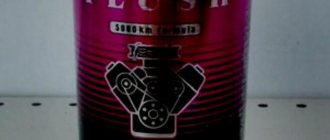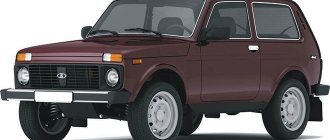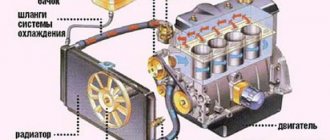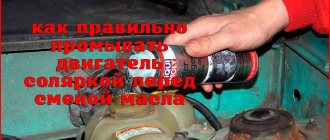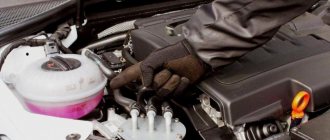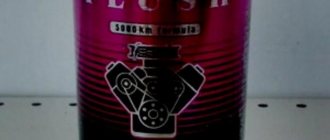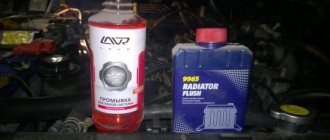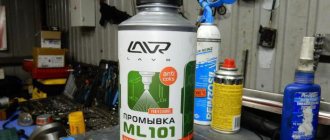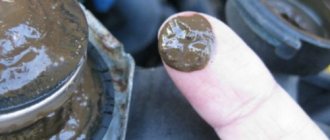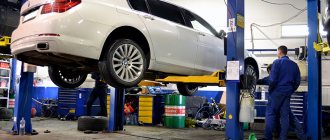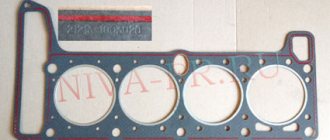Motorists are divided into 2 types: those who consider flushing to be a mandatory procedure and those who do not believe in its benefits and necessity. Our experience and knowledge in this matter allows us to expertly substantiate the importance of engine flushing and advise which flush is best used for what purposes. From the history
Flushing preparations appeared in the 1960s and early 1970s.
Moreover, in the USSR and in the West - at the same time. The domestic development
was used for cleaning low-speed diesel locomotive diesel engines.
It was liquid mineral oil with a reinforced complex of detergent additives. The washing procedure itself took 30 minutes or more. Over time, the drug began to be used for passenger vehicles, and commercial production of flushing oils began. The original technique had obvious disadvantages: 1) a significant amount of fluid remained in the engine; 2) low quality raw materials could harm highly accelerated engines. Western technologies
have taken a different path of development.
Economic calculations have shown the unprofitability of using petroleum products for flushing. For this reason, special flushing fluids appeared, which over time have undergone some changes and today are known to us as express flushes. Indications for use
Carbon deposits and resins inevitably appear in every engine: during engine operation, the oil oxidizes and forms a varnish film on the parts of the lubrication system. Products of incomplete combustion of fuel, wear of mechanisms and other contaminants stick to it. Gradually all this becomes solid deposits. It is difficult to watch this process, but it is easy to imagine, starting from examples from everyday life. Remember. What does grandma's frying pan look like that hasn't been washed for a long time? Over the years of operation, a dense layer of soot accumulates on it, which does not peel off depending on the temperature. but on the contrary, it hardens.
What does the formation of such a layer in the engine lead to? This leads to a disruption in the lubrication cycle of the motor, to accelerated wear of parts, and the detachment of a piece of such carbon deposits can seriously damage the engine. A serious risk is posed by deposits accumulated in the pressure relief valve of the oil supply pump, hydraulic tensioners of the gas distribution mechanism drive and hydraulic compensators, as well as on the oil intake screen. Even slight contamination of these elements can disrupt engine performance. In fact, motor oils must contain additives that protect against such deposits, which you can always read on the label. However, for additives to be effective, “normal” operating conditions must be observed. And the standard criterion is subjective. Often the oil begins to burn, forming tarry deposits.
Flushing is carried out to remove such deposits.
And LAVR offers an effective solution for this - adding the drug to old oil that has lost its cleaning properties.
Why flush the system if you can drain the old oil?
Even after draining, some of the used oil still remains in the engine lubrication system, and when mixed with new oil, it worsens its properties.
The remaining oil remaining in modern engines is 8-12% of the total oil volume in the system, and can reach 20% in older models (according to automakers). If cheap industrial oil is used for flushing (on the basis of which flushing oils are created), then even a relatively small residue in the system can significantly reduce the cleaning properties of the new oil. By the way, flushing oils are outdated, labor-intensive to use and, moreover, not environmentally friendly preparations. Variety of LAVR washes
Our recommendation is to use special wash concentrates. This is a modern and simple method that provides effective prevention of the formation of harmful deposits. LAVR oil system flushes not only remove contaminants, but also help remove as much old oil as possible. As a result, the service life of the new oil is extended and the lubrication system receives reliable protection.
Depending on the engine size, the degree of contamination and the flushing method, you can choose one of 4 LAVR products:
1) 5-minute engine flush LAVR Classic
This is a universal product that is used for regular flushing of all types of gasoline and diesel engines of passenger cars. The packaging is enough to flush the oil system of a 4-5 liter engine. A 5-minute LAVR can also be used to wash gearboxes and manual transmissions.
2) 5-minute engine flush LAVR Classic++ For commercial vehicles
First of all, the product is used for washing trucks and construction equipment. But it is acceptable to use it for cleaning passenger car engines, especially diesel ones. The 5-minute LAVR Classic++ engine flush contains a viscosity corrector, which provides engine protection if the oil is diluted with diesel fuel.
Cleaning: how to properly flush a car engine when changing the oil and when is the best time to do it
What to wash with
When the car is new, the problem of how to properly flush the engine when changing the oil does not arise. After all, it does not yet have a solid mileage, the owners say, in addition uttering a phrase about the inappropriateness of the internal combustion engine cleaning procedure. This is partly true, but it is worth remembering that the health of the power plant must be protected from a young age.
Recommendation. To avoid having to wash the power plant, you should pour only high-quality oil from new and not exceed its change interval of 7,500 km.
In the case of a new internal combustion engine, everything is clear. But what to do with contract engines and used cars. The answer is simple - clean the engine and fill it with new, high-quality lubricant.
Nowadays, the insides of the unit are cleaned not with flushing oil, but with catalyzing active chemistry. The special flush is a mineral oil with a package of aggressive additives. It comes in two types:
- five or seven minutes;
- soft (poured into oil 200-300 km before changing it).
Five minutes has a high content of alkaline and other caustic components. Experienced craftsmen express it this way: “It is recommended for use only on new engines or those that have been well cleaned by hand.” Soft flushing fluid causes fewer complaints, and among auto mechanics it is positioned as the only correct option.
How to clean
Initially, the cleaning composition is presented not as a product that washes the engine from the dirt that has accumulated there over several years, but as a detergent to maintain the cleanliness of a new or washed old engine. The conclusion here is that you cannot immediately pour the drug into an internal combustion engine with an unknown service history.
- drain the oil;
- remove the valve cover and oil pan;
- clean the removed elements with aggressive “medicines” (diesel oil, carburetor cleaner, kerosene...) and grinding;
- put everything in place;
- pour oil back;
- Wash the engine for five minutes.
We will analyze the cleaning procedure by rinsing using the LAVR cleaning composition as an example. According to reviews from admirers of the classic LAVR engine flush, the procedure for working with a five- or seven-minute composition looks like this:
- Warm up the engine to operating temperature.
- Turn off the car.
- Pour in the drug.
- Start up the internal combustion engine.
- Wait 5/7 minutes in idle mode.
- Stop the power plant.
- Drain the waste.
Attention! After cleaning with chemicals, the oil is changed to a new one. The filter must also be replaced.
This begs one question: why can’t we do without mechanical cleaning of power plant parts? Here's why: flushing will easily dissolve accumulated deposits in the crankcase and cylinder head. The latter will clog the oil intake screen, which will lead to oil starvation. This is deadly for a regular gasoline internal combustion engine and doubly bad for diesels and turbo engines. The way out of this situation is difficult - it is necessary to completely disassemble the engine and clean it.
It is noteworthy that when changing the oil base (for example, switching from mineral water to synthetic), you should not rinse with store-bought liquids. It is enough to drain the old one, fill in the new one and let the engine idle. Then the lubricant is drained again, the filter is changed, and the updated composition is filled in. You can do it another way:
- update the oil and replace the filter;
- drive 1,500-2,000 km.
Why do you need to flush the engine oil system?
So, even taking into account that the owner will use high-quality motor oil and change it regularly, contamination in the engine still cannot be avoided. The only thing is that the intensity of their formation will be reduced.
In other words, if you use, for example, cheap mineral oil or the most affordable semi-synthetic oil, and change such lubricant every 10-12 thousand km, then the engine will wear out more and become dirty very quickly. If you switch to hydrocracking or even synthetic oil with a replacement interval no later than 7-8 thousand km, then such an engine will remain clean much longer. However, the internal combustion engine must be serviced in this way from the very purchase of a new car.
Also, one should not assume that by 80-100 thousand mileage, even under such “ideal” conditions, deposits will not accumulate in the oil system. The reason is oil residues that cannot be completely drained as part of the replacement, heavy urban use, etc.
It becomes clear that pollution cannot be avoided. At the same time, it is also clear that it is optimal to remove them in advance for preventive purposes at the initial stage, before any problems begin with the engine (noisy operation, knocking of hydraulic compensators, decrease in pressure in the lubrication system, etc.).
Let us also add that car enthusiasts who change their oil 20-30% ahead of schedule often adhere to the opinion that an engine flush is not necessary when changing the oil. It is based on the assertion that the oil itself contains an active package of detergent additives that wash the engine and lubrication system.
Yes, this is true, but only partially. The fact is that a package of alkaline and other detergent additives is available, but in many cases it is not enough. Detergent additives work after 3-4 thousand km, that is, much earlier than the moment when the driver changes the oil again.
It turns out that you can wash the engine with oil, but to achieve results using this method, you will need to drain fresh oil several times literally every 2-3 thousand km. Obviously, such a procedure is very expensive in terms of budget.
At the same time, above we discussed only motors that were not very dirty to begin with. It often happens that the power unit has a mileage of about 200 thousand km. and more, the oil was changed according to dealer regulations without adjusting for operating conditions, there are doubts about the quality of the lubricant itself, frequent transitions were made from one type of oil to another, etc. In this case, it will take a very long time to wash the engine with oil alone, or it will not be possible to achieve the desired effect at all without using a special engine flush.
Article on the topic: Master brake cylinder: what is it and how does it work
Having decided that flushing is necessary, the question arises of which oil system cleaner to choose. You should also take into account some features of using engine flushes and contraindications that also exist. Let's figure it out.
What kind of Hi-Gear soft flush is it for a car engine or reviews about it
Why is this composition called “soft”? It's simple - the additive package in mineral oil is selected in a way that is beneficial for the engine. Unlike express washes, the concentration of aggressive components is lower here, and they work for a long time. In addition, the composition from an American company does not destroy rubber elements - this has been proven by experiments.
About the effect of Hi-Gear soft engine flushing, the reviews are unanimous – positive. For example, here is what Oleg N. from Novosibirsk writes:
“After sitting for a long time, my Subaru Outback suddenly started smoking. I filled up High Gear, but decided not to drive, but to “roll out” 200 km in engine hours. As a result, the car stood for 4 hours, idling. There was much less smoke. And after 50 km of running on the new oil, everything returned to normal.”
Much has been said about the effectiveness of the cleaning product. It is worth noting that this is the most successful deoxidizer of bitumen and oily deposits. His credit is that he does his job slowly. This means that malignant products will dissolve into small substances, mix with oil and, without clogging the meshes and small channels, come out as waste. This is confirmed by Nikolay M. from Tula, who has tried almost the entire Hi-Gear washing line. He formulated his review briefly:
- a soft drug is an effective and harmless thing;
- five-, ten-minute periods - they are washed, but the entire oil system is clogged with sludge;
- Flushing oils clean, but significantly damage camshafts and camshafts.
In short
- A competent flushing procedure first involves mechanical cleaning of the oil sump and valve cover, only then using auto chemicals. The essence of its application is simple - pour the composition into the oil, let the engine run and, depending on the type of flushing, drive with it. Next, the waste is drained, the filter is changed and new lubricant is refilled.
- When changing the oil base (synthetic - semi-synthetic, etc.), it is advisable to wash it with new oil, which is planned to be refilled further.
- There are accelerated washes and long-acting formulations, called soft ones. The latter have the advantage.
- Reviews of the Hi-Gear soft product are positive. In the technology of how to properly flush a car engine before changing the oil, there are cases when the flushing life is not rolled out in kilometers, but is developed in engine hours. This technology is less harmful to the engine, and the effect is almost the same.
- The LAVR line of automedicines is highly effective. The most popular is the “soft” liquid Motor Flush Soft.
This post is also more for myself)) Decoked and changed the oil! in 2 hours the liquid was completely gone, although this time I took 330 ml... here is the description of the procedure. Oil as always, and additionally did a rinse with a 5-minute LAVR rinse (I have never rinsed, but this time I decided to do it additionally after decarbonization) Plus I changed the air)
Method of use for cleaning the engine oil system:
Warm up the engine to operating temperature. Pour the drug into the oil filler neck and start the engine. Let it idle for 5 minutes. YOU CAN'T DRIVE A CAR! Stop the engine and drain the used oil. Replace the oil filter and add new oil.
LN2504 LAVR Engine decoking fluid -330.00 RUR; LN1003 LAVR Flushing the internal combustion engine -113.00 RUR; PAA033 PARTS MALL Air filter -144.00 RUR; W81180 MANN Oil filter -RUB 186.00
«The debate about the need for engine flushing has recently intensified. And all due to the fact that more and more used cars are appearing on the market than new ones. Panacea? Or harm? Are there many engine oil system flushes that are actually effective? Let's deal with everything in order.
»
The wash is poured into the oil before changing, mixed with the lubricant that has already exhausted its resource, and allowed to work for some more time (most often 5.10 minutes). Then the resulting liquid is drained and fresh oil is poured into the engine. All of these products contain cleaning additives similar to those found in regular motor oil or exclusively solvents. It is this fact that causes many to doubt whether such a composition will be able to wash away the sludge, oil and fuel combustion products that have accumulated over the years, in a few minutes or at least a couple of days of work.
You can flush the engine with several means - flushing oil, oil or a liquid with which you need to drive for a while. But the most popular remedy is a 5-minute engine flush . Since the last two drugs are used most often - due to their ease of use, we will consider their effectiveness in more detail.
Laurel: engine flushing, instructions, features of use
Let us immediately note that there are a large number of solutions for flushing the lubrication system on the market: Liqui Moly, Lavr, Xado, Hi-Gear, etc. You can also find so-called flushing oil, while in the Russian Federation drivers usually choose Lukoil or Zic.
Given such diversity, we decided to focus on one of the most widely represented and most popular products among engine flushes. We are talking about products under the Lavr brand.
By the way, we note that among the various products for flushing internal combustion engines, foreign companies usually do not offer the consumer ready-made flushing oils. The fact is that in Europe and other developed countries it is unprofitable to produce and use such oils. There is also an additional need for their disposal after use. It is much more rational to add active flushing to the used oil, which then still needs to be drained, as during a regular replacement.
As you can see, the most convenient and widespread is a preparation for flushing the oil system, which:
- poured directly into the mining;
- does not react dangerously with motor oil;
- maintains the required oil viscosity when flushing;
- effectively removes sludge and other deposits;
- does not have a pronounced negative effect on oil seals and seals;
First of all, although manufacturers of washes claim that their formulations do not affect the oil itself and simply improve its cleaning ability, in fact this is not the case. In practice, oil dilution still occurs. This means that you cannot load the engine while using flushing, that is, the unit should only operate at idle. Otherwise, reduced viscosity can lead to accelerated wear and engine failure.
As for the LAVR line of engine oil flushes, experts took this feature into account. As a result, the wash contains a so-called viscosity corrector. In fact, it is a polymer included in the composition that prevents severe liquefaction.
Another feature is the residue in the engine that cannot be drained. It is important that this residue, which is a mixture of waste and washing, is minimal and does not affect the fresh oil. To do this, first of all, the washing needs to ensure maximum fluidity.
If we talk about the Laurel line of cleaners and rinses, we should highlight the following products:
- Lavr “Classic” five-minute wash for cars and trucks, as well as other types of commercial vehicles. There is also a more intensive 7-minute washing of the Lavr engine.
- Soft flushing of the Lavr engine, designed for the internal combustion engine to be operated under moderate load for 150-200 km.
For a number of reasons, drivers often choose LAVR Motor Flush Soft 200 km. Its main difference is that you can drive with such a wash, it does not evaporate, and it also removes dirt more effectively than 5 and 7-minute “fast” compounds.
In other words, the mild oil system cleaner Lavr allows you to clean the engine for several days over 200 km, being an alternative to flushing oil. In this case, the internal combustion engine is operated under moderate loads during flushing.
LAVR Motor Flush Soft properties and practical test
So, the Motor Flush Soft detergent additive, better known as “soft flushing,” is poured into the engine lubrication system 150 or 200 km away. until the oil change is scheduled. One “portion” of this drug is enough to flush the lubrication system of such an engine, into which 4 to 6 liters are poured. oils
According to the manufacturer, washing delicately removes varnish and bitumen deposits, dissolves thickened gel-like contaminants, etc. At the same time, the presence of dispersants in the flushing composition protects the engine from wear and also helps prevent clogging of the oil system channels, oil receiver mesh and oil filter. Flushing also restores the elasticity of rubber seals and gaskets; the composition is compatible with all types of motor oils.
By the way, the problem of filter clogging when using washing is very relevant. Often, after cleaning the engine oil system with different compositions, there were cases where washing only partially dissolved deposits in the pan, then these viscous masses clogged the oil receiver mesh filter. As a result, the engine, even with a normal oil level on the dipstick, experienced oil starvation and failed.
Let's move on to using LAVR Motor Flush Soft. According to the instructions, the first step is to warm up the engine until it reaches operating temperatures. Next, the flushing is poured into the oil filler neck. After this, the motor should run in XX mode for about 5 minutes.
We also recommend reading the article on how to flush the engine when changing the oil. In this article, you will learn about the various methods available for flushing the engine before changing the engine oil.
Then you can drive the car without increasing the speed above 3 thousand, avoiding driving under tension, driving in high gears at low speed, etc. Maximum after 200 km. you need to drain the waste from the engine, replacing the oil and oil filter.
Attention! Independent laboratory tests have determined that although Lavr Motor Flush Soft contains trace elements such as Ca (calcium), Mg (magnesium), B (boron), Zn (zinc), and P (phosphorus), these components are still not indicate that the manufacturer has added anti-wear and extreme pressure additives to the flush. In practice, this means that Lavr Motor Flush Soft is actually an organic solvent.
It turns out that you can travel up to 200 km. after adding it to mining it is highly undesirable. In simple words, it is optimal if the engine “travels” these kilometers in the form of engine hours, that is, idling.
How does flushing work?
Quick (five-minute) flushing of the engine lubrication system works using a fairly simple method. This composition is poured into the lubrication system, after which the engine should run for about 5 - 10 minutes, and the liquid resulting from mixing is drained. The composition of the product for flushing into the oil before changing includes a large (so-called shock) dose of detergent components . Which in a short time can wash away old dirt, scale, deposits and other debris. This is evidenced by numerous engine flush tests. Their results can be found in sufficient quantities on forums and various resources on the Internet.
Sometimes on the Internet you can find conflicting reviews about a particular product, the essence of which boils down to a negative effect. However, this attitude is often the result of improper application of flushing. If the product contains aggressive substances, then with prolonged exposure to rubber seals there is a risk of damage to the latter. And this leads to an emergency situation. Therefore, before using this or that product, you must carefully read the instructions for its use and act in accordance with it.
Looking ahead, it is worth noting that the effect of using such rinses is indeed observed, but it is not as fantastic as their manufacturers write in the instructions . Therefore, the appropriateness of use remains questionable.
Flushing the Lavr engine. Reviews
Separately, we’ll find out what motorists think about the five-minute flushing of the “Lavr” engine. Looking ahead, let's say that this product has more positive reviews online than negative ones.
Almost all positive reviews about Lavr flushing are based on three theses:
- inexpensive compared to similar products;
- cleans the engine quite effectively, if you don’t expect impossible effects (removing large coke build-ups, washing off long-term varnish deposits, etc.);
- does not destroy oil seals if you do not violate the instructions for use.
Also, some motorists note a decrease in the intensity of leakage through the crankshaft or camshaft oil seals after using the “Lavr” flush. The fact is that light hydrocarbons penetrate the rubber and soften it. And if the oil seal itself was intact, and it had just lost its elasticity, then washing with some probability will restore its ability to seal the shaft. However, reverse effects are also known.
In negative reviews, motorists often mention low overall efficiency. This is usually due to the high expectations of car owners. For example, “Lavr” washes off a light emulsion from the internal surfaces of the engine if the broken cylinder head gasket was localized and replaced in time. Copes with light sludge deposits. If the emulsion has completely filled the engine, or the sludge has been building up in the crankcase for years, then no amount of flushing will help.
Car owners also say that using flushing can suddenly open engine leaks through the crankshaft and camshaft seals. If the seal has mechanical damage, the solvents in the flush will completely destroy it.
>
What means are used to flush the engine?
Despite the fact that most washes act similarly, they are still divided into several classes. Among them:
- "Five Minutes" . As a rule, they are based on an organic solvent, which allows you to quickly and rapidly wash away dirt and deposits. The advantage of such products is their high speed of action. Disadvantages - along with dirt, the “five-minute” can wash away the lubricant from working mechanical pairs. As a result, scratches may appear on the parts. Therefore, such drugs can only be used when the engine is idling.
- Soft engine flushes . They are added to the oil approximately 100.300 kilometers before the scheduled oil change. They act more gently than previous products, since their base is created from calcium sulfonates (something like soap and similar detergents). In addition to the base, the composition includes dispersing additives.
- A mixture of the first two options . These can be a variety of compositions containing both solvents and detergent components with additives. As practice shows, universal tools are not as good as special ones tailored to solve a specific problem.
There is another class of rinses, which can conditionally be called folk, but they also belong to the “hard” class. For decades, before the advent of modern chemicals, motorists added various solvents, including acetone or solvent . This solution does exist, but with some limitations:
- The effect of such remedies is very limited in time. They are allowed to work literally for 3.5 minutes. Naturally, during this time they will only be able to wash off surface deposits.
- Under no circumstances should you increase the speed when there is such a flush in the engine!
As an example, we list several popular compounds belonging to certain classes (naturally, their true number is many times greater).
Remember that all of the listed remedies are preventative and are not intended to decarbonize the engine. And also that before filling in new permanent oil, it is advisable to purge the system with a compressor or use a vacuum pumping device in order to remove all remaining oil mixture in the engine (after traditional draining, about 200.300 grams always remain).
